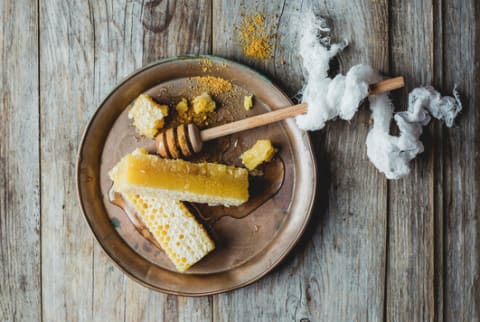Advertisement

Most of you know the negative effects of excess sugar. Sugar is empty calories that can lead to hormonal imbalances and weight gain, not to mention it’s addictive!
And hopefully, you also know that artificial sweeteners are just as bad for you. They’re filled with potentially harmful chemicals, have no nutrition, and in my experience, trigger more sugar cravings.
But what about all the natural sweeteners that are being marketed as “healthier” alternatives to sugar, such as honey, maple syrup, agave, coconut sugar, stevia, etc.?
First of all, let me tell you flat out: These natural options are still SUGAR (with the exception of stevia). And too much of any sugar can lead to increased risk of diabetes, heart problems, fatty liver, obesity, hormonal imbalances, and more.
What differentiates them is primarily:
- The glycemic index (GI) and the effect they have on your blood sugar
- The percent of fructose (which is extra work for your liver, and is said to convert to fat quicker)
- The added nutrients that can partly offset the negatives of the sugar
Regular table sugar is 50 percent fructose and has a GI of about 60 to 65, so ideally you want alternatives with lower fructose and GI and some added nutrition.
Here are my four favorite sweeteners:
1. Raw honey
Why I like it: I’m a bit obsessed with raw honey given all of its uses and health benefits. Raw honey has natural enzymes that are great for digestion, has antimicrobial properties, antioxidants, and small amounts of minerals and vitamins. Its GI is a lot lower than sugar, around 35 to 50 depending on the type.
Note: Conventional honey is pasteurized so lacks these beneficial raw enzymes, and has an extremely high GI. So always opt for raw, and if you can afford it, try Manuka honey, which has the most enzymes.
Uses: So many! I use it as a face wash/mask as it’s great for acne. It’s also great for fighting a cold, so if you’re getting sick, there's nothing better than a warm ginger tea with lemon and raw honey. It can even help with cuts/burns.
And if I need a tad of sweetener in my teas, oatmeal, smoothies, or homemade desserts, raw honey is my go-to.
2. Maple syrup
Why I like it: First, it tastes delicious. But also, it contains lots of antioxidants, small amounts of minerals, and it’s lower in calories than honey. It has a lower percent of fructose (around 35 percent) and lower GI (around 50 to 55) than sugar, so it’s less likely to cause a spike in your blood sugar.
Note: Make sure it has only one ingredient—100 percent pure maple syrup (with no added high-fructose corn syrup or other additives).
Uses: I use it in salad dressings, for sweet veggie recipes, to bake my granola or healthy desserts, and, of course, to drizzle on pancakes!
3. Stevia
Why I like it: Stevia extract is derived from the South American stevia plant, which has been around for centuries. It has no calories and has very little impact on your blood sugar. If you don’t mind the taste, this might be your #1 option.
Note: Make sure you buy 100 percent pure stevia extract; try to avoid stevia in most packaged products and packets that are processed and not pure stevia. Also, it’s important to use sparingly as it's over 100 times sweeter than sugar (and can have an aftertaste).
Uses: I use a VERY SMALL amount to sweeten my smoothies, chia puddings, or oatmeal if they need a tiny bit of extra sweetness. It’s also great to sweeten homemade lemonade or tea. It’s not great for baking, though.
4. Coconut palm sugar
Why I like it: I love everything coconut! It’s made from the sap of the coconut palm, less processed than refined sugar, and retains some of the nutrients found in coconut. It’s claimed to have lower GI (around 35) and less fructose versus regular sugar (as coconut sugar is 70 to 80 percent sucrose). However, in terms of calories, it’s the same as sugar.
Uses: I use it just for baking in lieu of regular sugar.
Surprising options that are less healthy than you think:
Brown Sugar
Commercial brown sugar is basically white refined sugar with just a bit of molasses added back in, so the effect is mostly the same as regular sugar. It’s high in both glucose and fructose, bad for your blood sugar and liver, and usually contains pesticides.
Agave
Agave became a popular option because of its low GI (around 20) but it has an extremely high fructose content, even higher than high-fructose corn syrup.
Fructose tends to be harder to digest, is not regulated by insulin the way glucose is, and there is evidence suggesting it can contribute to problems with your gut, liver, triglyceride levels, and insulin sensitivity.
What are the worst options?
High-fructose corn syrup and all artificial zero-calorie sweeteners including Aspartame (Equal, NutraSweet), Saccharin (Sweet’n Low), and even Sucralose (Splenda)! All zero-calorie sweeteners can trick your brain into thinking you’re having something sweet and often trigger sugar cravings.
Sugar is sugar, and whether it has calories or not, excess amounts can lead to weight gain. Ideally, you should train yourself to use less sugar/fewer sweeteners.
That being said, small amounts of raw honey, maple syrup, stevia, and coconut sugar are great and always in my pantry.
Watch Next
Enjoy some of our favorite clips from classes
Enjoy some of our favorite clips from classes
What Is Meditation?
Mindfulness/Spirituality | Light Watkins
Box Breathing
Mindfulness/Spirituality | Gwen Dittmar
What Breathwork Can Address
Mindfulness/Spirituality | Gwen Dittmar
The 8 Limbs of Yoga - What is Asana?
Yoga | Caley Alyssa
Two Standing Postures to Open Up Tight Hips
Yoga | Caley Alyssa
How Plants Can Optimize Athletic Performance
Nutrition | Rich Roll
What to Eat Before a Workout
Nutrition | Rich Roll
How Ayurveda Helps Us Navigate Modern Life
Nutrition | Sahara Rose
Messages About Love & Relationships
Love & Relationships | Esther Perel
Love Languages
Love & Relationships | Esther Perel


















